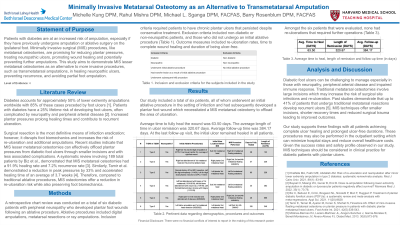Case Series/Study
(CS-142) Minimally Invasive Metatarsal Osteotomy as an Alternative to Transmetatarsal Amputation
Friday, May 2, 2025
7:45 PM - 8:45 PM East Coast USA Time

Michelle Kung, DPM – Resident, Podiatric Surgery, Beth Israel Deaconess Medical Center; Rahul Mishra, DPM – Resident, Podiatric Surgery, Beth Israel Deaconess Medical Center
Introduction: Patients with diabetes are at an increased risk of amputation, especially if they have previously undergone amputation or ablative surgery on the ipsilateral foot. Minimally invasive surgical (MIS) procedures, like metatarsal osteotomies, are promising for reducing plantar pressures, treating neuropathic ulcers, promoting wound healing and potentially preventing further amputations. This study aims to demonstrate MIS lesser metatarsal osteotomies as an alternative to more invasive procedures, such as transmetatarsal amputations, in healing neuropathic ulcers, preventing recurrence, and avoiding partial foot amputation.
Methods: Six diabetic patients with neuropathy and foot infections requiring ablative procedures were included in this study. Each underwent a MIS metatarsal osteotomy to offload plantar wounds. Data were collected through chart reviews, interviews, and follow-up visits, focusing on reulceration rates, wound healing time, and ulcer remission duration.
Results: The average time for complete wound healing was 63.5 days, with an ulcer remission period averaging 320.67 days. The follow-up period averaged 384.17 days, during which no reulcerations required further operations.
Discussion: Diabetic foot wounds, especially in the forefoot, are challenging due to factors like neuropathy and impaired immune response. MIS metatarsal osteotomies offer significant benefits in promoting faster healing and maintaining foot biomechanics, reducing the risks associated with larger surgical incisions, and providing effective pressure offloading. The results suggest that MIS procedures are a safe and effective option for managing diabetic foot ulcers.
Methods: Six diabetic patients with neuropathy and foot infections requiring ablative procedures were included in this study. Each underwent a MIS metatarsal osteotomy to offload plantar wounds. Data were collected through chart reviews, interviews, and follow-up visits, focusing on reulceration rates, wound healing time, and ulcer remission duration.
Results: The average time for complete wound healing was 63.5 days, with an ulcer remission period averaging 320.67 days. The follow-up period averaged 384.17 days, during which no reulcerations required further operations.
Discussion: Diabetic foot wounds, especially in the forefoot, are challenging due to factors like neuropathy and impaired immune response. MIS metatarsal osteotomies offer significant benefits in promoting faster healing and maintaining foot biomechanics, reducing the risks associated with larger surgical incisions, and providing effective pressure offloading. The results suggest that MIS procedures are a safe and effective option for managing diabetic foot ulcers.

.jpg)